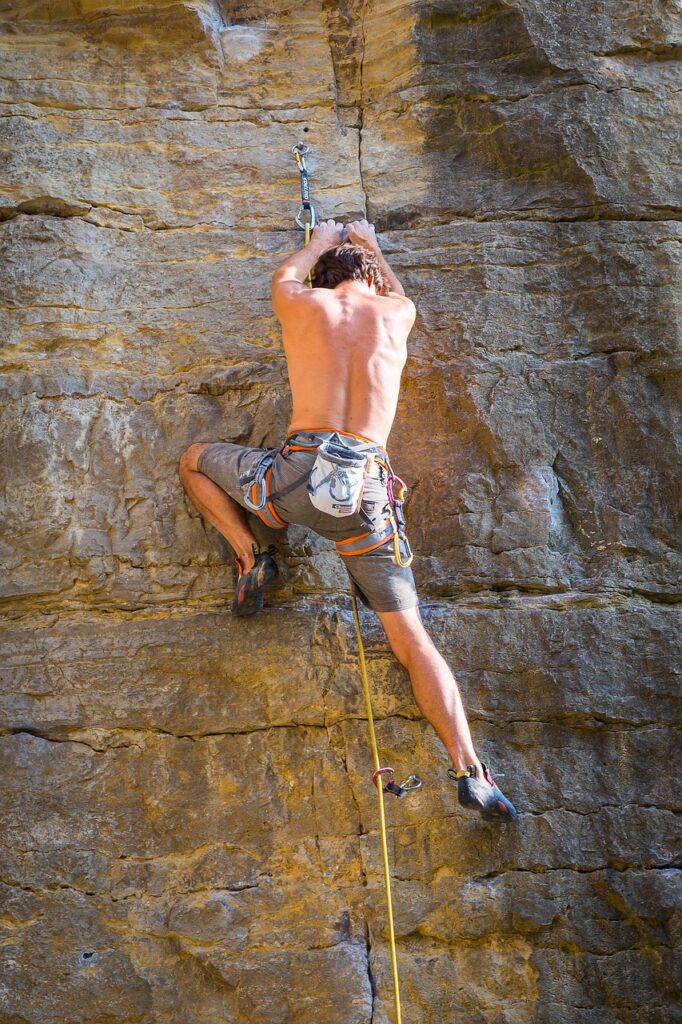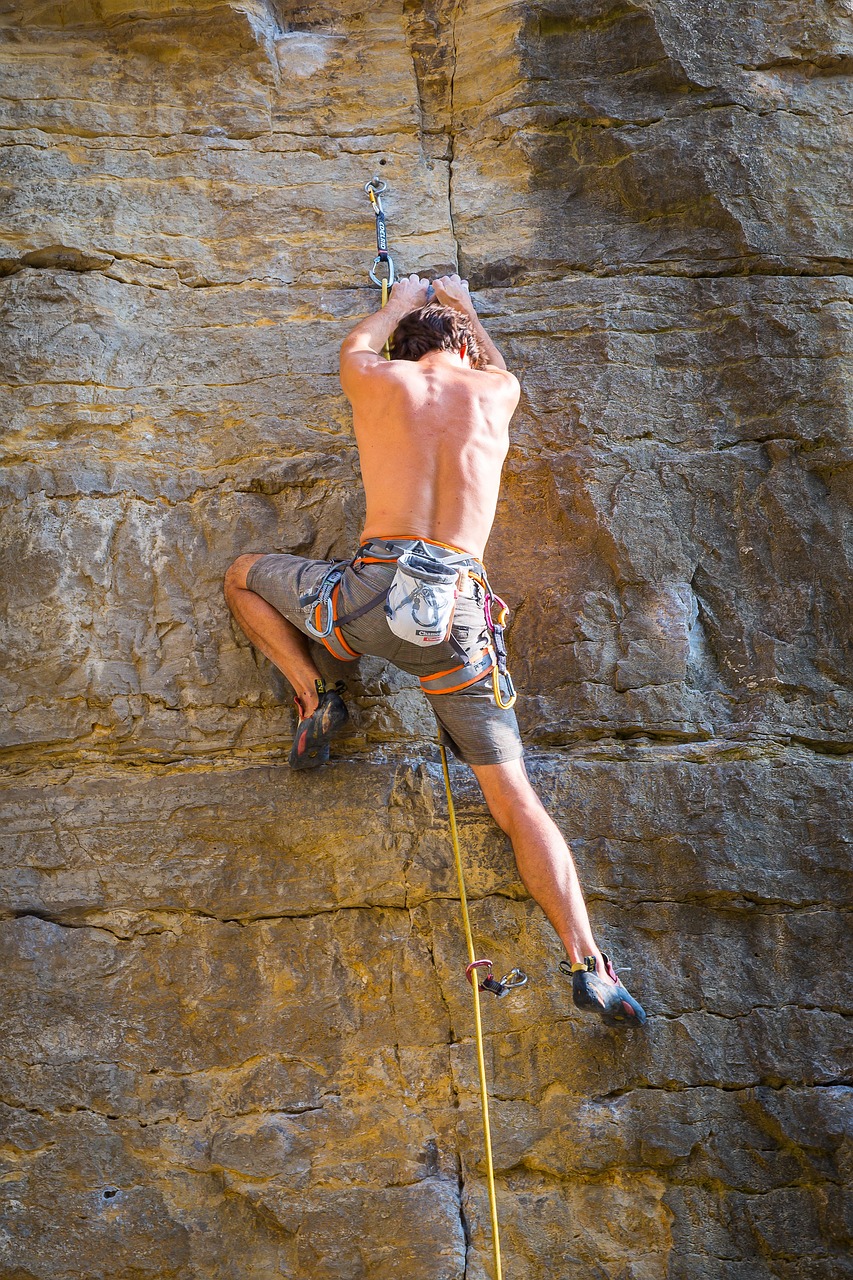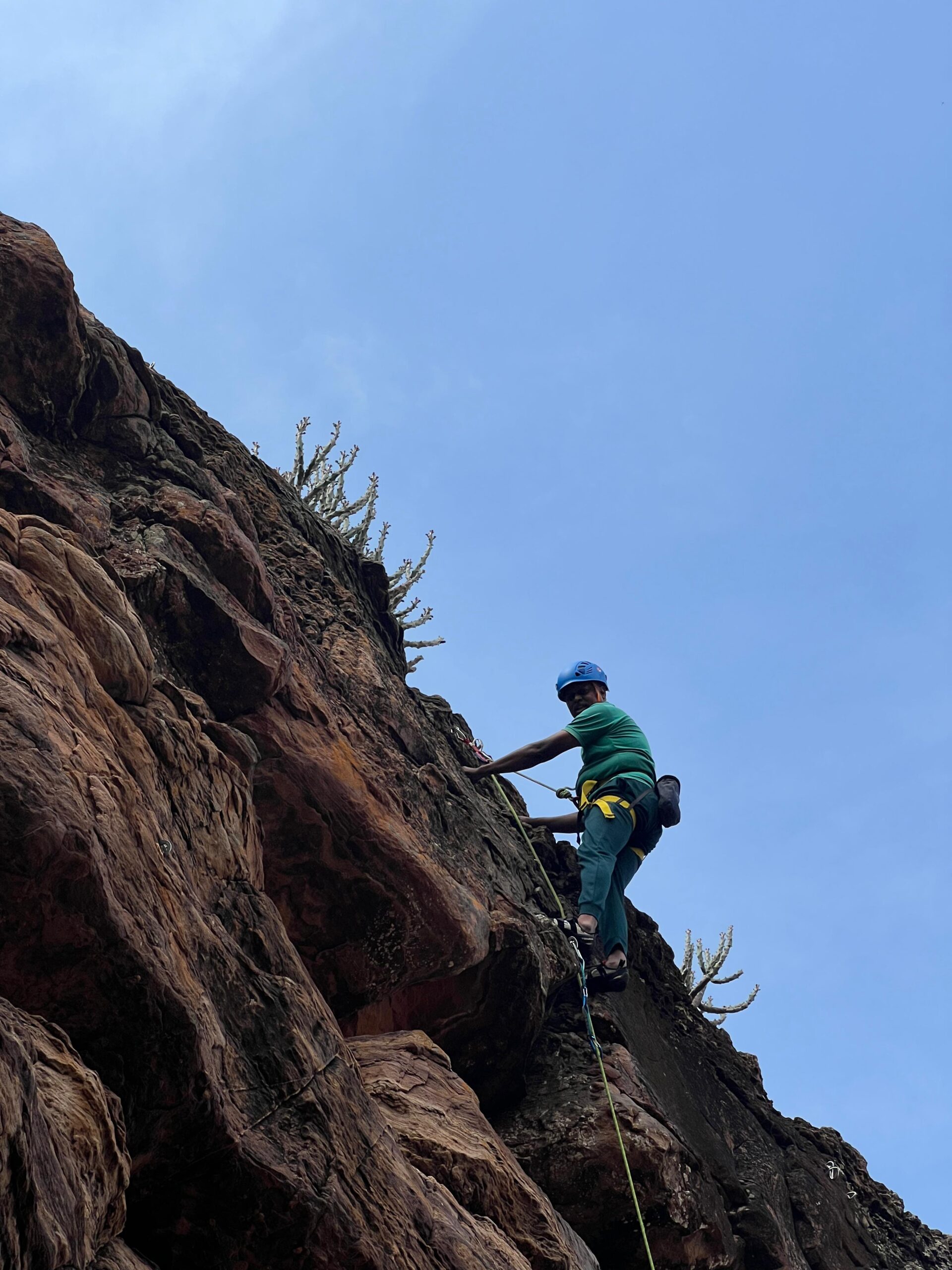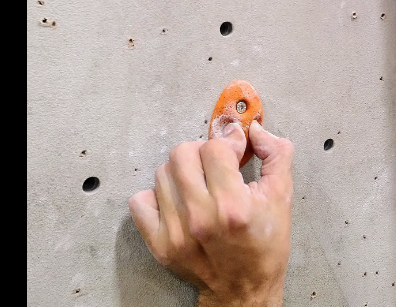Whether climbing is better than going to the gym depends on your fitness goals, preferences, and the experience you’re looking for. Both have unique benefits, and the “better” choice varies for each person. Here’s a comparison to help you decide:
1. Full-Body Workout
- Climbing:
- Provides a total-body workout, engaging muscles in your arms, legs, back, and core.
- Builds functional strength, flexibility, and balance while improving coordination and problem-solving skills.
- More dynamic and varied than traditional gym routines, making it feel less monotonous.
- Gym:
- Allows you to target specific muscle groups with tailored exercises (e.g., weightlifting for strength, cardio machines for endurance).
- Offers structured workouts with consistent progression, ideal for building muscle or achieving specific fitness goals.

2. Cardiovascular Benefits
- Climbing:
- Provides moderate cardio during sustained climbs, especially on long routes.
- Challenges your endurance and cardiovascular system, though not as intensely as dedicated cardio workouts.
- Gym:
- Offers a wide range of cardio machines (e.g., treadmills, bikes, rowers) for focused cardiovascular fitness.
- Great for high-intensity interval training (HIIT) or steady-state cardio.
3. Mental Engagement
- Climbing:
- Engages your mind as much as your body. Requires focus, strategy, and problem-solving to navigate routes.
- Overcoming challenges on the wall builds confidence and resilience.
- Provides a sense of adventure and accomplishment that gyms often lack.
- Gym:
- Allows for mindfulness or zoning out, as many routines are repetitive.
- May not be as mentally stimulating, though some classes (like group fitness or CrossFit) can be engaging.
4. Accessibility and Convenience
- Climbing:
- Requires access to a climbing gym or outdoor climbing spots, which may not always be nearby.
- Gear and memberships can be more expensive compared to basic gym memberships.
- Gym:
- More accessible in most areas, with flexible hours and a wide range of equipment for various fitness levels.
- Offers consistent conditions, unlike outdoor climbing, which depends on weather and location.
5. Social Experience
- Climbing:
- Highly social, with climbers often working together to solve problems and encourage each other.
- Great for building a sense of community and meeting like-minded adventurers.
- Gym:
- Can be social if you attend group classes or train with a partner, but many people work out alone.
- Less interactive unless you participate in group activities.
6. Fun and Motivation
- Climbing:
- Often feels more like play than exercise, making it easier to stay motivated.
- The challenge of completing a route or reaching the top keeps climbers coming back for more.
- Gym:
- Provides structured progress through tracked lifts, weight increases, or endurance improvements.
- Can feel routine over time, though variety (like group classes or different machines) helps maintain interest.
Conclusion
- Choose Climbing if: You want a full-body, mentally stimulating workout that feels like an adventure. It’s ideal for those seeking fun, social engagement, and functional strength.
- Choose the Gym if: You have specific fitness goals (e.g., muscle building, weight loss, or endurance training) and need flexibility, accessibility, and structured progression.
For the best results, consider combining both! Use climbing for variety and adventure, and supplement with gym workouts to target specific fitness goals.
Can rock climbing burn fat?
Yes, rock climbing can burn fat and is an excellent full-body workout that helps with weight management and overall fitness. Here’s how it contributes to fat burning:
1. Calorie Burn
- Climbing Burns Significant Calories:
- Rock climbing is a physically demanding activity that combines strength, endurance, and cardio. Depending on your weight, climbing can burn 500–900 calories per hour for moderate to intense climbing sessions.
- The calorie burn can be even higher during prolonged climbs or challenging routes.
- Creates a Calorie Deficit:
- To lose fat, your body needs to burn more calories than you consume. Climbing helps create this deficit, especially when paired with a healthy diet.
2. Builds Muscle and Boosts Metabolism
- Muscle Engagement:
- Rock climbing activates multiple muscle groups, including your arms, legs, back, and core. Building muscle increases your resting metabolic rate (RMR), meaning your body burns more calories even when at rest.
- The more muscle you build through climbing, the better your body becomes at burning fat over time.
- Afterburn Effect:
- Climbing is a high-intensity workout that can trigger excess post-exercise oxygen consumption (EPOC), also known as the “afterburn effect.” This means your body continues to burn calories at an elevated rate even after your climbing session.
3. Combines Strength and Cardio
- Rock climbing is a hybrid workout that incorporates both strength training and cardiovascular exercise:
- Strength Training: Pulling yourself up, holding positions, and pushing with your legs builds muscle and burns fat.
- Cardio: Sustained climbing increases your heart rate, which helps burn calories and improve cardiovascular fitness.
4. Stress Reduction and Fat Loss
- Climbing Reduces Stress: Stress can lead to fat gain through increased cortisol levels, which promote fat storage (especially in the abdominal area). Rock climbing is an engaging activity that reduces stress and helps keep cortisol levels in check.
- Mental Focus: The concentration required in climbing can distract from stress-eating habits or sedentary behaviors.
5. Consistency and Variety
- Sustainable Exercise: Climbing is enjoyable and engaging, which makes it easier to stick to compared to repetitive workouts like running or cycling.
- Variety Keeps You Active: Trying different climbing routes and styles (bouldering, sport climbing, trad climbing) prevents workout boredom and keeps your body adapting, which supports continued fat loss.
Tips for Maximizing Fat Loss Through Climbing
- Climb Regularly: Aim for 2–3 sessions per week to stay consistent.
- Incorporate Other Activities: Combine climbing with other cardio exercises like running or swimming for additional fat-burning benefits.
- Eat a Balanced Diet: Focus on lean protein, healthy fats, and complex carbs to fuel your climbs and aid recovery while maintaining a calorie deficit.
- Focus on Intensity: Challenge yourself with harder routes or longer climbs to maximize calorie burn.
- Rest and Recover: Proper rest is crucial for muscle repair and continued progress.
Conclusion
Rock climbing is an effective way to burn fat because it combines calorie-burning, muscle-building, and cardiovascular benefits in an enjoyable, engaging activity. While it won’t deliver instant results, regular climbing combined with a healthy lifestyle can lead to noticeable fat loss and improved overall fitness.
Rock climbing is an activity that can be enjoyed by people of all ages, from young children to older adults, depending on their physical condition and interest. The “best” age to start or excel in rock climbing varies based on goals, body development, and individual preferences. Here’s a breakdown of how climbing fits different age groups:
1. Children (Ages 4–12)
- Why it’s great:
- Kids have natural flexibility, lightweight bodies, and a fearless attitude, making it easier for them to learn climbing techniques.
- Rock climbing fosters problem-solving skills, confidence, and coordination.
- What to consider:
- Focus on fun and safe environments, such as indoor climbing gyms with kid-friendly routes.
- Ensure proper supervision and well-fitting gear.
2. Teenagers (Ages 13–18)
- Why it’s great:
- Teens have increasing strength and endurance, making this a great time to develop technical skills and start tackling more challenging routes.
- It’s an excellent way to stay active, build confidence, and develop a lifelong passion.
- What to consider:
- Encourage proper technique and training to prevent injuries, especially during growth spurts.
- Climbing with peers can enhance social bonds and make it more enjoyable.
3. Young Adults (Ages 19–35)
- Why it’s great:
- Peak physical fitness typically occurs during these years, with the ability to combine strength, flexibility, and endurance for advanced climbing.
- This is the age group where many climbers achieve their highest performance levels, often taking on demanding outdoor and competition climbing challenges.
- What to consider:
- With proper training and conditioning, young adults can push their limits while minimizing the risk of injury.
- Balance climbing with cross-training for optimal performance.
4. Middle Age (Ages 36–50)
- Why it’s great:
- Experienced climbers in this age range often have refined techniques and mental focus, allowing them to excel even as physical performance begins to plateau.
- Climbing can be a fantastic way to stay fit and active, providing both strength and cardiovascular benefits.
- What to consider:
- Recovery times may lengthen, so focus on proper warm-ups, stretching, and rest days.
- Pay attention to joint health and avoid overtraining to prevent injuries.
5. Older Adults (50+)
- Why it’s great:
- Rock climbing keeps older adults active, improves balance and coordination, and strengthens muscles and bones.
- It’s a low-impact workout that can be tailored to individual fitness levels.
- What to consider:
- Prioritize safety, use appropriate routes, and avoid overexertion.
- Consult with a doctor if you have any health concerns, especially for high-impact climbing styles like bouldering.
When is the Best Age?
- The best age for rock climbing depends on your goals:
- Recreational Fun: Anytime! Children and adults can enjoy climbing as a fun and social activity.
- Peak Performance: Typically during young adulthood (19–35), when physical capabilities are at their highest.
- Lifelong Activity: Climbing can be adapted to any age and fitness level, making it a lifelong sport.
Tips for All Ages
- Start Small: Begin with indoor gyms or beginner-friendly routes.
- Stay Consistent: Regular practice helps build skill and strength.
- Listen to Your Body: Prioritize safety, and don’t push past your limits.
- Enjoy the Process: Whether you’re 7 or 70, climbing is about enjoying the journey and the challenges it brings.
Rock climbing is a versatile sport that anyone can enjoy at almost any stage of life. The key is to approach it with enthusiasm and adapt it to your physical abilities.
Yes, you can learn the basics of rock climbing by yourself, but it’s important to approach it with caution and proper preparation to ensure safety. While self-learning can be effective for certain aspects of climbing, some elements—particularly those involving safety systems and techniques—are best learned with the guidance of experienced climbers or instructors. Here’s how you can start climbing safely and effectively:
1. Start Indoors at a Climbing Gym
- Indoor gyms are the safest place to learn climbing on your own. They provide:
- Pre-set routes with varying difficulty levels.
- Padded flooring to minimize injury risks (especially for bouldering).
- Access to equipment rentals, like climbing shoes and chalk.
- Benefits of starting in a gym:
- Controlled environment with no weather or external hazards.
- Staff or experienced climbers can offer advice if needed.
2. Learn Basic Climbing Techniques
- Focus on foundational techniques to build confidence and avoid bad habits:
- Footwork: Place your feet precisely on holds rather than relying solely on your arms.
- Body Positioning: Use your legs to push yourself up and keep your center of gravity close to the wall.
- Grip Types: Learn how to use different holds (e.g., crimps, jugs, slopers) effectively.
- Watch online tutorials or read books to understand climbing movements and strategies.
3. Practice Bouldering First
- Bouldering is a great entry point because it requires less gear and focuses on shorter routes, usually with padded mats for safety.
- No need for ropes, harnesses, or belaying.
- Emphasizes technique, problem-solving, and strength-building.
- Start with easy routes (V0–V2) and gradually increase difficulty as you build skill.
4. Learn Safety Basics
- Safety is critical, especially if you move beyond bouldering. You’ll need to learn:
- How to fall safely: Practice landing softly with bent knees and rolling if necessary.
- Rope systems: If you plan to sport climb or top-rope, understanding knots, belaying, and anchors is essential.
- Proper gear usage: Learn how to use a harness, belay device, and carabiners.
5. Transition to Outdoor Climbing Gradually
- Outdoor climbing involves additional risks, such as loose rock, weather, and longer falls. Start with:
- Bouldering outdoors: Bring a crash pad and climb with a spotter for safety.
- Top-roping: A beginner-friendly outdoor climbing method where the rope is anchored above you.
6. Find Resources and Community
- Online Resources: Watch instructional videos, read blogs, or take online courses to understand climbing concepts.
- Climbing Community: Join climbing groups or forums where you can ask questions and learn from experienced climbers.
- Look for local climbing meetups or events to connect with others.
7. Know When to Seek Guidance
- Some skills, such as belaying, lead climbing, or building anchors, require hands-on instruction to ensure safety.
- Taking a beginner climbing class or hiring a guide is a worthwhile investment to avoid accidents and develop proper techniques.
8. Essential Gear for Learning
- Climbing Shoes: Improve grip and footwork.
- Chalk and Chalk Bag: Keeps your hands dry for better hold.
- Harness and Belay Device: Needed for rope climbing (if progressing beyond bouldering).
Challenges of Self-Learning
- Risk of developing bad habits or unsafe practices without feedback.
- Limited understanding of advanced safety systems like anchor building or lead climbing.
- Outdoor climbing involves unique challenges, such as route finding and weather considerations, that are easier to navigate with experienced partners.
Conclusion
You can begin learning rock climbing on your own by starting with indoor bouldering and studying basic techniques. However, as you progress to more advanced forms of climbing or outdoor routes, seeking guidance from experienced climbers or certified instructors is highly recommended for safety and skill development. A mix of self-learning and mentorship will give you the confidence to climb safely and enjoyably.
Yes, rock climbing is a useful skill with applications that extend beyond recreation. It builds physical fitness, mental resilience, problem-solving abilities, and self-confidence. While it might not be a survival skill in everyday life for most people, the benefits of rock climbing make it valuable in many areas. Here’s why rock climbing is considered useful:
1. Physical Benefits
- Full-Body Strength: Climbing develops muscles in your arms, legs, back, and core, improving overall fitness and functional strength.
- Flexibility and Balance: Maintaining body positioning on the wall enhances flexibility and balance.
- Endurance: Sustained climbing improves cardiovascular health and muscular endurance.
These physical improvements can aid other sports, outdoor activities, or daily tasks requiring strength and coordination.
2. Mental Benefits
- Problem-Solving Skills: Every climb is like solving a puzzle, requiring strategic thinking to navigate routes efficiently.
- Focus and Concentration: Staying present and assessing each move teaches mindfulness and mental clarity.
- Resilience: Climbing builds mental toughness and perseverance, as you learn to overcome fear, failure, and physical challenges.
These mental skills transfer to professional and personal situations where problem-solving and focus are essential.
3. Practical Survival Skills
- Outdoor Survival: In scenarios like hiking or mountaineering, climbing skills can help you traverse challenging terrain or reach inaccessible areas.
- Emergency Situations: If you find yourself in a precarious situation in nature, basic climbing knowledge can assist in self-rescue or helping others.
4. Social and Team-Building Skills
- Collaboration: Activities like belaying in rope climbing require trust and teamwork.
- Community Building: Climbing fosters connections with like-minded individuals, improving social interaction and teamwork skills.
5. Recreational and Professional Applications
- Adventure Sports: Climbing opens the door to other outdoor activities like mountaineering, canyoneering, or ice climbing.
- Career Opportunities: Skills learned in climbing can lead to careers in guiding, search and rescue, outdoor education, or adventure tourism.
6. Overcoming Fear and Building Confidence
Climbing helps you confront fears, such as heights or failure, in a controlled environment. Each success—whether completing a tough route or reaching the top—boosts self-confidence and courage.
7. Environmental Awareness
Climbers often develop a deep appreciation for nature, as the sport immerses them in outdoor environments. This connection fosters environmental stewardship and conservation efforts.
Conclusion
Rock climbing is a versatile and beneficial skill, offering physical, mental, and social advantages. While it may not be an essential daily skill for everyone, its ability to enhance fitness, problem-solving, and resilience makes it incredibly valuable for personal development, outdoor adventures, and building a fulfilling lifestyle.


